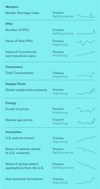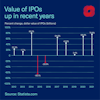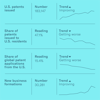Published
January 10, 2023
At the start of 2023, businesses are facing a multitude of economic challenges: the threat of a recession, the worker shortage, overregulation, geopolitical uncertainty. The economic indicators and data visualizations below reflect this, painting a mixed picture of our economy.
While American businesses are strong and optimistic right now, there is fear that the state of the economy is weak—and confidence in government to do what they can to help is low.
The U.S. Chamber's 2023 State of American Business event on January 12, 2023, highlighted the role of business-led innovation and the role of government in advancing smart policy to chart a more secure and robust economic future for our nation.
WHAT'S NEW IN 2024? See our latest State of American Business Data Center
American Business by the Numbers
The State of American Business Data Center analyzes 12 economic indicators around workers, IPOs, consumers, supply chains, energy, and innovation to diagnose the health of American businesses and the economy. Jump to each section below for more analysis and data visualizations.

Worker Shortage: 10.5 Million Unfilled Jobs

The pandemic caused huge shifts in the U.S. labor market. The U.S. is experiencing a labor shortage being caused by dwindling legal immigration, early retirements, and other barriers keeping workers out of the labor force like access to childcare.
-
10.5M
Unfilled jobs in the U.S.
-
6M
Unemployed workers in the U.S.
The Chamber’s Worker Shortage Index number indicates the number of available workers for every job opening. The current Worker Shortage Index reading is 0.73, not far off the all-time-low of 0.63 in March 2022. This means that for every 100 job openings there are only 73 available workers.

While job growth has been strong this year, the country is moving in the wrong direction for labor force participation. If the percentage of people participating in the labor force was the same as in February 2020, we would have nearly 3 million more people in the workforce today.
Bottom line: Government can help by taking steps to increase legal immigration while securing the border, by improving access to childcare, by incentivizing work, and by financing training programs that lead to good jobs. The Chamber's America Works Initiative policy priorities detail these solutions.
IPO Market, Loan Markets Sagging

Businesses need capital to start their enterprises, to run them efficiently, and to grow. Business growth is stronger when capital is more accessible. The issuance of initial public offerings (IPOs) is an indicator of the vitality of the economy. More companies go public when growth prospects are strong and they need access to the deep pool of capital going public affords.
The private sector plays a leading role in driving innovation to solve problems, but the number of IPOs coming to market has dropped below average. Higher taxes, inflationary spending, government overreach, and overregulation saps the innovation needed in our economy.

Although the number of IPOs was below average in 2022, the number of IPOs issued and the dollar value of IPOs have been up the last few years. The surge in 2021 was in large part due to the growth in Special-Purpose Acquisition Companies (SPACs). Before the SPAC surge, there was little growth in the number of IPOs.

The dollar value of IPOs has showed strong growth in some years, implying it was bigger companies going public after spending more years private. More traditional IPOs (not through SPACs), where younger companies acquire the capital they need to grow from the offering, would make the economy more vibrant and dynamic.
Bottom line: Smart government policy will help the economy by encouraging, not disincentivizing, companies to go and stay public.
For smaller businesses, Commercial and Industrial (C&I) Loans are their primary source of vital capital to grow and thrive. The value of C&I loans issued has been strong.

Bottom line: As the Federal Reserve continues to tighten monetary policy to fight inflation, C&I loans will fall making it harder for many companies to access financing.
Consumer Consumption Strong

Businesses exist to serve their customers. The more customers they have, and the more those customers spend, the better it is for business. Consumers have continued to spend despite turbulent economic conditions over the past few years. The remarkable resilience of the American consumer has been one of the top economic storylines since COVID-19 struck.

Even though inflation is near 40-year highs, spending is up even more. For example, retail sales—spending at retail stores and bars and restaurants—rose a surprising 1.3% in October 2022, which exceeded inflation. Prices rose 0.4% in October, so inflation-adjusted retail sales rose a hardy 0.9%.
Bottom line: Savings from the COVID-19 shutdown period are helping customers keep up with inflation, but this cannot last indefinitely and is a trend to watch in 2023.
Supply Chain Strains Finally Easing

U.S. businesses are linked together through a global web of interconnected supply chains and rely on them to access national and international consumers and compete in the global marketplace.
An efficient supply chain is crucial to business growth. The New York Federal Reserve tracks pressure on the global supply chain. Higher levels indicate higher stress on the system.

Pressure on the global supply chain was stable for years leading up to COVID-19. It spiked during the pandemic, and remains elevated compared to pre-pandemic levels, although it has come down substantially in recent months.
Bottom line: A well-functioning supply chain is a key component of reducing inflation.
Energy Prices Coming Down

Energy is an enormous input cost for businesses. When energy prices rise, businesses either have to absorb those costs and see their earnings decline, or pass them on to customers in higher prices.
Energy prices, as indicated by the price of oil, were mostly steady in the years before COVID-19. They fell while much of the global economy was shuttered in response to the pandemic, then rose to record highs as global economies reopened.
Currently, the Russian invasion of Ukraine is also causing oil prices to remain high, although prices have fallen slightly in recent months.
Bottom line: American energy production delivers economic advantages to U.S. families and businesses and diminishes the economic strength of aggressors like Russia. The most important thing Washington can do this year to help is to send long-term signals to energy producers to give them the confidence and certainty they need to invest.
An Uneven Innovation Ecosystem

For the economy to continue growing, it must have innovation. Existing businesses need to create new products and improve existing ones. New businesses are needed to bring fresh ideas to market.
-
121,164
U.S. granted patents in 2011
-
183,147
U.S. granted patents in 2020
The number of patents issued is a gauge of how much innovation is occurring in the economy over time — and the U.S. continues to churn out patents in strong numbers.

COVID-19 brought the number of patents issued in the U.S. down, but only slightly. While the number of patents issued is strong, less than half go to U.S. residents.

Overall, the U.S. is still the prime place for innovation globally. But we need more innovation from U.S. residents, and we need to make it easier and more inviting for innovators from other countries to bring their ideas here.
Chinese innovators apply for roughly two-thirds of all patents. The U.S. and Japan have almost all the rest of the applications. Countries with more patents will see more dynamism in their economies.

The U.S. Chamber's International IP Index evaluates intellectual property (IP) rights in 55 global economies across 50 unique indicators — from patent and copyright policies to ratification of international treaties.
The U.S. had the highest score of 95.48 out of 100, signaling a strong IP framework; but the global average remains below 60, illustrating there is still significant room to improve the framework for innovation and creativity in global markets.
New business formations drive innovation
Like patents, new businesses are the future generators of economic growth. The more new businesses, the better, because having strong numbers of new businesses increases the potential amount of future high-performing enterprises.
The years 2020 and 2021 saw the largest increase in new business applications in recorded history. Before the pandemic, the number of applications filed monthly to start a new business averaged just under 300,000. In 2021, they averaged 450,000, according to U.S. Census Bureau data.
Nearly 5.4 million applications were filed to form new businesses in 2021 — the most of any year on record going back to 2005.
-
3.5M
Total new business applications in 2019
-
5.4M
Total new business applications in 2021
The U.S. Census Bureau tracks monthly the number of new business formations projected in the next four quarters. That data below also shows the uptick in new businesses created during the pandemic.

New business formations were steady before COVID-19, but at the start of the pandemic, new business formations skyrocketed.
Bottom line: This could be an aberration of the pandemic, or it could signal a shift to a renewed entrepreneurial spirit. This is an indicator to watch in the next year to know for sure.
Conclusion
The indicators above help measure the health of business and the economy—like going to the doctor and being reminded of your cholesterol levels or heart rate. While businesses are largely on strong footing, the economic data has led economists to predict a mild but short recession in 2023.
In this moment, businesses must stay optimistic and lean into the things that the American business community does so well—the ability to compete and succeed in our free enterprise system, the drive to innovate, the grit when getting through tough times, and the opportunity to improve communities and society.
Despite the fragile economy, American businesses will keep working to do the things that society needs, expects, and trusts them to do.
The State of Small Business
Our quarterly Small Business Index with MetLife captures the current sentiments of small business owners, their view on the economy, and the biggest challenges they are facing.
About the authors

Curtis Dubay
Curtis Dubay is Chief Economist, Economic Policy Division at the U.S. Chamber of Commerce. He heads the Chamber’s research on the U.S. and global economies.

Isabella Lucy
Isabella has created stunning visualizations tackling pressing issues like the worker shortage, the benefits of hiring veterans, the lifespan of small businesses, and the future of work.









